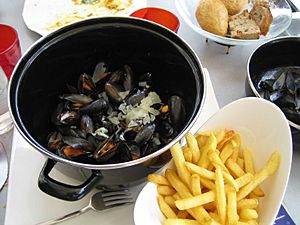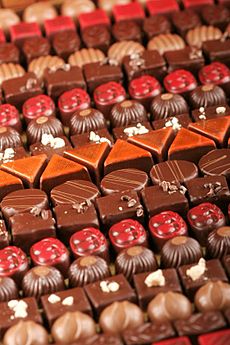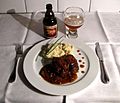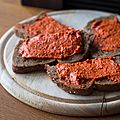Belgian cuisine facts for kids


Belgian food is super varied and has been influenced by its neighbors like France, Germany, and the Netherlands. People sometimes say that Belgian food gives you big portions like German food, but with the amazing taste of French food! Outside of Belgium, the country is most famous for its yummy chocolate, crispy waffles, golden fries, and many kinds of beer.
Even though Belgium has many special national dishes, popular foods like hamburgers and spaghetti bolognese are also eaten there. Most foods Belgians enjoy are also popular in nearby countries. So, "Belgian cuisine" usually means dishes that started in Belgium or are seen as very typical Belgian foods.
Belgian cooking often uses fresh ingredients from the region and season. Common ingredients in Belgian dishes include potatoes, leeks, grey shrimp, white asparagus, Belgian endive, and local beer. They also use common European foods like meat, cheese, and butter. Belgians usually eat four meals a day: a light breakfast, a medium lunch, a snack, and a big dinner.
Belgium has many dishes and products that are special to certain areas. For example, waterzooi comes from Ghent, the couque biscuit is from Dinant, and tarte au riz is from Verviers. Even though these foods started in specific places, people all over Belgium enjoy them.
Contents
Belgian Food: A Tasty Adventure
A Look at History
Belgian food has a long history. It was first shaped by the Roman Empire. Later, it was influenced by the foods of France, Germany, and the Netherlands.
We don't know much about the very first Belgian cooking. But we can guess it was like what other early European tribes ate. Ancient Belgians likely gathered food, raised animals like sheep and cattle, and grew root vegetables. They also hunted animals like wild boar and fished. Beer was made back then too, but without hops. It was probably brewed using barley.
When Belgium was part of the Roman Empire, many new foods came to the area. These included cabbage and other leafy greens, plus fruits like apples, pears, and grapes. Belgium was known for supplying a lot of ham and pork to Roman cities. During the Middle Ages, poor people often ate pottage, which was a thick soup or stew.
Delicious Main Dishes
Belgian food is known for its hearty and flavorful main courses. Here are some favorites:
- Moules-frites / Mosselen met friet: This is one of Belgium's national dishes! It's mussels cooked with onions and celery, served with Belgian fries. It's also very popular in northern France.
- Carbonade flamande / Vlaamse karbonaden/stoofvlees: This is a Belgian beef stew. It's like the French beef bourguignon, but it's made with Belgian beer instead of red wine. It's usually served with bread or fries and mustard. People often enjoy a beer with it. This is also seen as a national dish, along with moules-frites.
- Steak-frites / Biefstuk met friet: A very common and popular dish in Europe. It's simply steak served with fries.
- Waterzooi: A rich stew or soup made with chicken or fish, vegetables, cream, and eggs. It's a specialty from Ghent.
- Chicons au gratin / Gegratineerd witloof: This dish features Belgian endives baked with cheese in a creamy béchamel sauce. Often, the endives are wrapped in ham.
- Kip met frieten en appelmoes / Poulet avec des frites et compote: A simple but popular dish of chicken, fries, and compote (fruit sauce), very common around Brussels.
- Konijn in geuze / Lapin à la gueuze: This is rabbit cooked in gueuze, a special Belgian beer from the Brussels area.
- Filet américain: Very finely minced raw beef. It's often spread on a sandwich or bread, sometimes with a special sauce, and served with fries.
- Paling in 't groen / Anguilles au vert: Eel cooked in a green sauce made from mixed herbs like chervil and parsley. It's served with bread or fries.
- Pêche au thon / Perzik met tonijn: Halved canned or fresh peaches filled with a mix of tuna and mayonnaise, like a tuna salad.
- Boudin / Pens: A type of sausage, often eaten with potatoes and apple sauce.
- Stoemp: Mashed potatoes mixed with other vegetables, usually carrots or cabbage. It's often served with sausages.
- Vol-au-vent: A small, hollow case made of puff pastry filled with chicken, mushrooms, and small meatballs in a white sauce. It's usually served with fries.
- Boulets à la Liégeoise / Luikse balletjes: Two large meatballs served in a sweet and sour sauce called sauce lapin, with fries.
Sweet Treats and Desserts
Belgium is also famous for its delicious sweet dishes and desserts.
- Gaufres / Wafels: Belgian waffles are famous! They are sometimes eaten as a street snack. Well-known types include the Gaufre de Liège (Liège waffle) and the Brussels waffle.
- Speculoos: A crispy cinnamon biscuit, traditionally baked for Saint Nicholas Day on December 6th.
- Croustillons / Smoutebollen: Deep-fried balls of dough, often eaten at fairs or on special days.
- Rijstevlaai / Tarte au riz: A pie with a rice pudding filling, originally from Verviers.
- Sirop de Liège / Luikse siroop: A jam-like spread made from cooked-down fruit juices.
- Cuberdon: A cone-shaped purple candy made of gum arabic, first made in Ghent.
- Lacquements: Thin wafers, cut in half and filled with a sugar candy syrup flavored with orange blossom.
Belgian Fries: A National Treasure
Fries, or deep-fried potato sticks, are super popular in Belgium. Many believe they were invented there! The first mention of fried potatoes in Belgium dates back to 1781. It described how people near the river Meuse had been eating fried potatoes since around 1680. Even though they are called "French fries" in some places, it's thought that American soldiers during the First World War called them that because the Belgian soldiers who shared the dish spoke French.
In Belgium, you can buy fries at fast-food stands or special fry shops called friteries, frietkot, or frituur. They are often served with many different sauces and eaten by themselves or with other snacks. Traditionally, fries come in a cone-shaped paper wrapper, with the sauce on top. Larger portions might be in cardboard trays. Other street foods like frikandel (a type of sausage) or meatballs are also sold there. Sometimes, fries are put into a baguette sandwich with sauce and meat; this is called a mitraillette.
Most Belgian homes have a deep fryer to make their own fries and other fried foods. Supermarkets sell different types of fats for frying, and beef fat is especially popular.
Sauces for Fries
Traditionally, fries in Belgium are served with mayonnaise. Fry shops offer many different sauces for fries and meats. These include aïoli (garlic mayonnaise) and sauce américaine. There are often more than a dozen choices, and many of them are mayonnaise-based. Some popular ones are:
- Sauce andalouse—mayonnaise with tomato paste and peppers.
- Bicky sauce—a special commercial sauce.
- Brazilian sauce—mayonnaise with pureed pineapple, tomato, and spices.
- Cocktail sauce—often served with seafood.
- Curry ketchup—a spiced ketchup.
- Curry mayonnaise—mayonnaise with curry spices.
- Joppiesaus—another commercial sauce with onion and curry powder.
- Ketchup—a sweet and tangy tomato sauce.
- Mammoet sauce—mayonnaise with tomato, onion, garlic, and soy sauce.
- Mayonnaise—the classic thick, cold sauce.
- Pepper sauce—mayonnaise or hot sauce with black pepper.
- Relish—chopped pickled vegetables, used as a condiment.
- Sauce lapin—a sweet and sour sauce made from sirop de Liège, often with raisins and prunes.
- Samurai sauce—mayonnaise with chili, spices, and bell peppers.
- Tartar sauce—a mayonnaise-based sauce with diced pickles.
Sometimes, fry shops also offer warm sauces like Hollandaise sauce or béarnaise sauce. Most of these sauces can also be bought in supermarkets. They are used on many other dishes, not just fries.
Belgian Beer: A World of Flavors
For a small country, Belgium makes a huge number of beers in many different styles. It has more unique types of beer per person than almost anywhere else! In 2011, there were 1,132 different kinds of beer made in Belgium. The tradition of brewing beer in Belgium goes back to the early Middle Ages. Six Trappist Monasteries still make beer today, which they first brewed to help pay for their monasteries.
On average, Belgians drink about 157 liters of beer each year. Most beers are bought or served in bottles, not cans. Almost every type of beer has its own special glass. Using the right glass is thought to make the beer taste even better.
The many different Belgian beers mean you can pair them with each part of a meal:
- Wheat beer goes well with seafood or fish.
- Blonde or Tripel beers are good with eel, chicken, or white meat.
- Dubbel or other dark beers pair well with dark meat.
- Fruit Lambics are great with dessert.
Many traditional Belgian dishes use beer as an ingredient. One example is carbonade, a beef stew cooked in beer. The type of beer used often depends on the region, so the taste of the dish can change. Another dish is rabbit cooked in gueuze beer. The Trappist monastery at Chimay also makes cheese that is "washed" with beer to make its flavor stronger.
Jenever: Belgium's Traditional Spirit
Jenever, also called genièvre or Dutch gin, is Belgium's national spirit. It's actually where gin came from! While beer might be Belgium's most famous drink, jenever has been the country's traditional spirit for over 500 years. Jenever is a "Protected Product of Origin" by the European Union. This means it can only be made in Belgium, the Netherlands, and a few small areas in France and Germany. Most of these special protections are just for Belgium, making Belgian jenever a unique secret in the world of drinks.
For hundreds of years, jenever has been sold in special jugs made from clay. Their unique shape is easy to recognize. Traditionally, Belgians serve jenever in very full shot glasses that have just come out of the freezer. To drink it the traditional way, you keep the glass on the table, bend down, and take the first sip without holding the glass. After this first sip, you can pick up the glass and drink the rest normally.
Belgian Chocolate: A Sweet Masterpiece

Belgium is famous for its high-quality chocolate. There are over 2,000 chocolate makers, big and small, in the country! Belgium's connection to chocolate goes back to 1635, when the country was under Spanish rule. By the mid-1700s, chocolate became very popular, especially as hot chocolate, among richer people. From the early 1900s, Belgium could bring in lots of cocoa from its African colony, the Belgian Congo. Both the chocolate bar and the praline were invented by the Belgian chocolate industry. Today, chocolate is still very popular in Belgium, with 172,000 tons made each year and sent all over the world.
The rules for what can be called Belgian chocolate have been in place since 1884. To make sure the chocolate was good quality, a law said it must have at least 35% pure cocoa. Following traditional ways of making chocolate also helps keep its quality high. For example, many Belgian chocolatiers do not use vegetable fats. Many companies still make chocolates by hand, which takes a lot of work. This is why you see many small, independent chocolate shops, which tourists love. Famous chocolate companies like Neuhaus and Guylian follow old (and sometimes secret) recipes for their products.
Seafood pralines (chocolates shaped like sea shells or fish) are very popular with tourists and are sold everywhere in Belgium.
Some famous Belgian chocolate companies are Côte d'or, Leonidas, Guylian, and Neuhaus.
Images for kids
-
The usual Herve cheese.
-
The Trappist beer, Chimay Brewery, and Grand Cru cheese.
-
Belgian endives in a market.
-
Sirop de Liège on a slice of bread.
-
Chicken waterzooi
-
Carbonade flamande / Stoverij with fries and salad
-
Cuberdon candies
-
Pain d'épices / ontbijtkoek spiced bread
-
Speculoos cookies
-
Fresh Liège waffles
-
A couque de Dinant biscuit
See also
 In Spanish: Gastronomía de Bélgica para niños
In Spanish: Gastronomía de Bélgica para niños





























